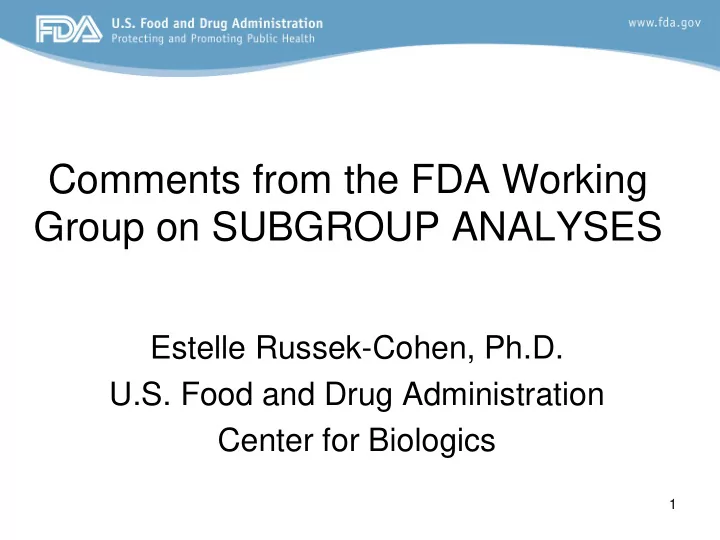

Comments from the FDA Working Group on SUBGROUP ANALYSES Estelle Russek-Cohen, Ph.D. U.S. Food and Drug Administration Center for Biologics 1
Outline • An intro to FDA • EMA and FDA on subgroups • Companion diagnostics and subgroups 2
FDA Organization Center for Center for Devices Center for Drug Biologics and Radiological Evaluation and Evaluation and Health Research Research National Center Center for Food for Toxicological Safety and Applied Research Nutrition Center for Office of Center for Veterinary Regulatory Tobacco Medicine Affairs Products 3
FDA • FDA: Drugs, Biologics and Devices • We have 3 Center Working group on Subgroups: Focused on therapeutic trials • Currently: internal white paper • FDA also regulates diagnostic tests, some may define subgroups in therapeutic trials. 4
FDA Call to Action (8/14) • Reporting of trial results by demographics (age, gender, ethnicity,…) • Guidance for reporting of sex-specific data for medical devices clinical trials …principles extend beyond device trials • Overall concern of representativeness of patients within a trial re: postmarket populations. 5
Similarities to EMA Document • Subgroup analyses: could inflate type 1 error cannot save failed trials • Concerns over ad hoc analyses 6
Consistency of Treatment effect Demographic groups (age, sex, ethnicity) FDA guidelines on age categorization US v. OUS in multiregional studies Disease severity; previous therapies Common concomitant medications Generally regarded as descriptive; not for purpose of group specific indication. If inconsistencies occur, an explanation is sought. Could impact indication. 7
Possible differences in emphasis • Description of interactions • Non-inferiority studies when subgroups are considered • Role of Bayesian subgroups analyses ……shrinkage estimators • Role of lab tests: ”companion diagnostics” 8
Interaction Hypotheses • Greater discussion of qualitative and quantitative interactions and impact on approval/indications for use. • Power is maximized when: 2 groups with 50% in each (e.g. gender). Given total sample size, power is worse if group sizes uneven. • Power for interaction hypotheses is low. 9
Noninferiority • Should the margins be the same within each group? 10
Bayesian subgroup analyses • A priori assumption of exchangeability of treatment effects • Posterior estimates: shrinks subgroup effects towards each other • Perhaps this can be helpful in limiting impact of random highs… provide effect estimates to size next trial • Several papers by Dixon and Simon. 11
Companion diagnostic (8/14): • An IVD companion diagnostic device is an in vitro diagnostic device that provides information that is essential for the safe and effective use of a corresponding therapeutic product. The use of an IVD companion diagnostic device with a therapeutic product is stipulated in the instructions for use in the labeling of both the diagnostic device and the corresponding therapeutic product, including the labeling of any generic equivalents of the therapeutic product . 12
Prognostic or Predictive? • Companion diagnostics usually fall into the class of predictive markers but they can include safety markers. • Prognostic markers can include markers to stratify or enrich at time of study design. • Prognostic or Predictive: Burden of proof? • Companion diagnostics have been approved for several oncology drugs. These have been regarded as high risk devices and PMA required. Not all assays are created equal. 13
Assays to define subgroups • Different assays for same analyte? • Tumor markers are used as companion diagnostics in oncology trials: tumor heterogeneity & analytical variation • The current EMA guideline does not address role of the assay in defining subgroups nor how such biomarkers are incorporated into study. 14
FDA References (Aug. 2014) • FDA Action Plan to Enhance the Collection and Availability of Demographic Subgroup Data • In Vitro Companion Diagnostics Devices: Guidance for Industry and FDA Staff • Evaluation of Sex-specific Data in Medical Device Clinical Studies: Guidance for Industry and FDA Staff 15
Reference • Dixon DO, Simon R. Bayesian subset analysis. Biometrics 1991; 47:871–882. 16
Recommend
More recommend